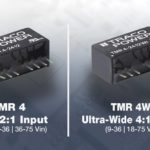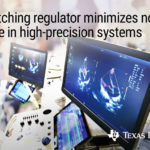The first part of EEWorld’s two-part “virtual roundtable” discussion on power system design considerations for wireless IoT nodes and wearables focuses on the use of low dropout regulators (LDOs). Our panelists are Kyle Van Renterghem, (KVR) Marketing & Applications Manager, Low Input Voltage LDOs, Texas Instruments, and Julian Hagedorn (JH), Systems Engineer, Texas Instruments. JS: […]
Regulators
Power conversion considerations for wireless IoT nodes and wearables, Part 1
Power system considerations are an important aspect of all system designs. In the case of wireless Internet of Things (IoT) nodes and wearables, power system design is complex, with the need to balance numerous performance tradeoffs. It is critical to arrive at a successful design that maximizes both battery life and overall functionality. Fortunately, there […]
4 W regulated dc-dc converters bridge industry’s 3- 6 W gap
TRACO POWER’s new 4 watt regulated DC-DC converters are available with either 2:1 (TMR 4) or 4:1 (TMR 4WI) input ranges, bridging the 3 to a 6-watt gap of industry-standard SIP-8 converter solutions. The TMR 4 (2:1 input range) and TMR 4WI (4:1 input range) are two families of regulated 4 Watt DC-DC converters with […]
Hybrid EVs come to touring car racing
The British Touring Car Championship (BTCC) in 2022 will become the first major touring car event to feature high-performance mild-hybrid vehicles. The BTCC is for production-based touring cars and consists of a series of races held across England and Scotland. Race teams compete in highly modified versions of cars sold to the general public. Next […]
Low-noise dc/dc switching regulators host integrated ferrite-bead compensation
Texas Instruments introduced a new family of low-noise DC/DC switching regulators with integrated ferrite-bead compensation. The TPS62912 and TPS62913 offer low noise of 20 µVRMS for frequencies ranging from 100 Hz to 100 kHz and ultra-low output-voltage ripple of 10 µVRMS, giving engineers the ability to remove one or more low-dropout regulators (LDOs) from their designs, […]
12-V option now available for switching regulator series
RECOM Power has extended it’s highly efficient and economical R-78E series of switching regulators to include a 12V option compatible with TO-220 linear regulators. RECOM was one of the first companies in the industry to widely promote and manufacture high efficiency switching regulators modules to replace the discrete TO-220 packaged linear regulators with its 78-series. […]
Buck-boost regulator features ultra-low quiescent current
Renesas Electronics Corporation introduced the ISL9122A, a flexible buck-boost switching regulator with bypass mode that provides ultra-low quiescent current (IQ) for powering sensors, microcontrollers (MCUs), wireless devices, and other system components. Operating with battery output from 1.8V to 5.5V, the ISL9122A extends the battery life of smart IoT devices powered by coin-cell, lithium, and multiple […]
Automotive PMICs include high-current dc-dc Buck converters
The DA913X-A product family is a new line of highly efficient, high-current, automotive-grade, step-down dc-dc (Buck) converters. The highly integrated DA913X-A devices require fewer external components than competing solutions, enabling a low system BoM cost and a reduced solution footprint. The devices operate at efficiency levels above 90%, reducing the thermal design challenges for powering […]
300-W buck-boost dc-dc converter series augmented with 5 to 28-V 12.5-A models
New 12.5-A 300-W-rated models have been added to the i7C non-isolated dc-dc converter series. With an input range of 9 to 53 Vdc, the output can be adjusted from 5 to 28 V. The i7C topology enables a seamless transition from buck (voltage reduction) to boost (voltage increase) operation. The series is ideal for generating […]
ZVS buck regulators handle 22 A in BGA tin-lead packages
Vicor has released two new ZVS buck regulators the PI3323 and the PI3325, with an extended operating temperature range of –55 to +120°C and an optional tin-lead 10 x 14mm SiP BGA package for Mil COTS applications. These high-density and high-efficiency buck regulators have a 14 – 42V input voltage range and support nominal outputs […]











